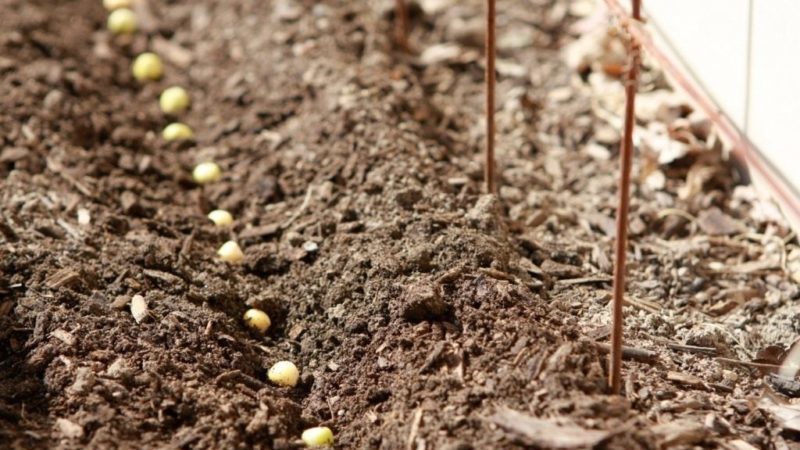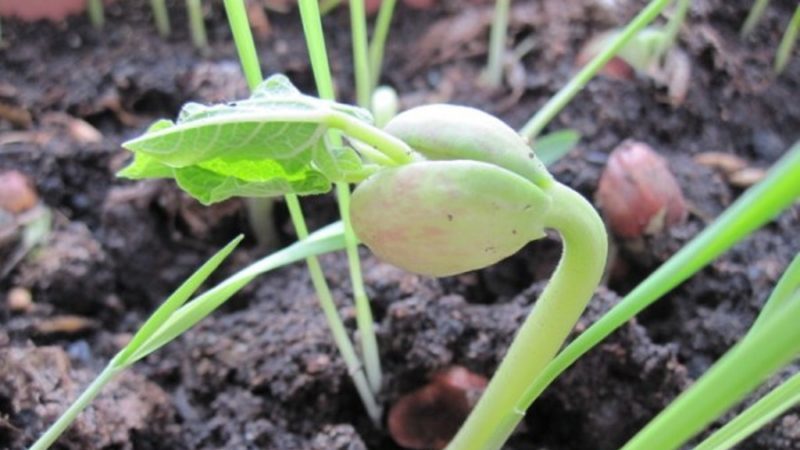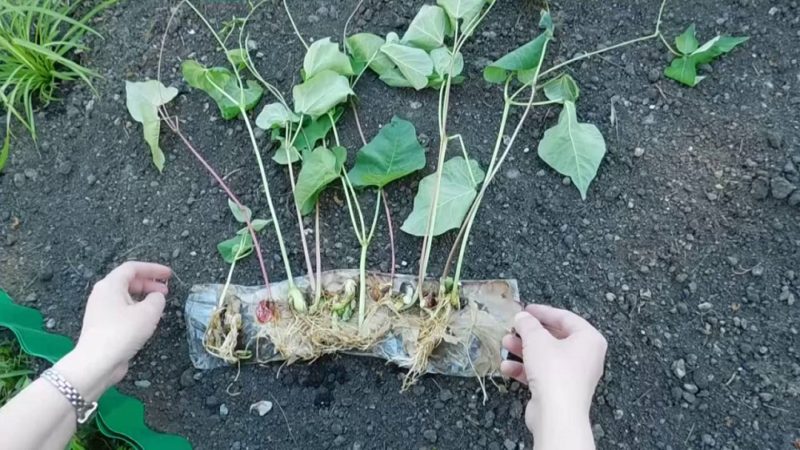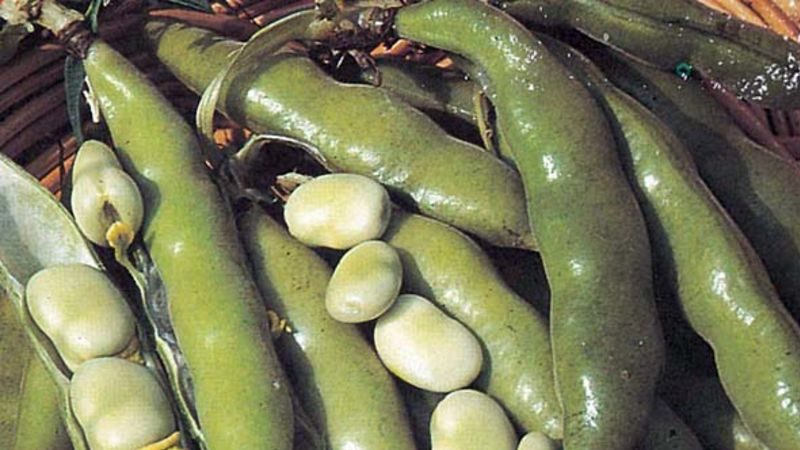How to grow beans outdoors
The beans do not require careful maintenance and are highly resistant to insect pests and infectious diseases. Watered in an arid climate every 4-5 days, top dressing is applied 2-3 times per season. A developed root system does not allow weeds to develop, and nodule bacteria enrich the soil with nitrogen. For planting a crop, it is only important to prepare the seeds and loosen the soil. From this article you will learn about growing and caring for beans in the open field.
The content of the article
How to seed beans outdoors

Planting beans in the garden solves several problems at the same time:
- enriches the soil with nitrogen;
- loosens the soil;
- prevents the growth of weeds and the washing out of the upper layers of the soil by rain;
- provides a rich crop of high-calorie beans.
To achieve these goals, prepare seeds and a place for planting legume, take into account the intricacies of agricultural technology.
Preparing seeds at home
It is recommended to manually inspect each seed for damage and deformation. To germinate the beans, you need 2 pieces of cloth soaked in water. On the first, the seed is evenly spread, the second is covered from above.
Attention! The fabric should be slightly damp. In no case should you take wet rags from which you can squeeze out plenty of water. Excessive moisture will cause seeds to rot.
An alternative way of germination is to place the seed in a container with water for 5-6 hours or in a growth stimulator for 4 hours.
Fertile land for growing beans
To cultivate beans, a slightly acidic, neutral or alkaline soil is required. Plants can survive even on poor soil, but in this case, the summer resident will receive a meager harvest. The root system of beans contains nitrogen-releasing nodule bacteria. The latter enriches the soil by stimulating plant growth and development.
It is not recommended to plant seeds in cold or waterlogged soil - there is a risk that the seed will rot. Before planting legumes in September or October, dig up the soil.
The acidity level in the soil is regulated with lime. Before planting beans, it is recommended not only to loosen the poor soil, but also to add organic fertilizer or wood ash to it. If the plant is planned to be grown in an arid region, the seedlings are watered, but not too abundantly.
How to plant beans

Seeds are planted in early November. Residents of the northern regions, where frosts come earlier, are advised to choose frost-resistant varieties.
These include:
- Windsor;
- Amber;
- Russian black beans.
Depending on the variety and height of the adult plant, the planting pattern is different. Dwarf beans are planted using the 20x20 cm technology. For taller plants, another scheme is provided - the culture is planted more closely, at a distance of 10 cm from each other. A distance of 40 cm is maintained between the rows.The planting depth is up to 7 cm.
Reference! If the climate in the region is cold and rainy, it is better not to plant legumes immediately in open ground, but to grow seedlings in a greenhouse. In this case, the seed is distributed in small pots at the end of December. The grown seedlings are transplanted to the garden in March.
When planting seeds in open ground, no top dressing is required. The nodule bacteria and nutrients remaining in the substrate after the precursor culture provide the beans with everything they need for normal growth. If planting is carried out in spring, then 2 weeks before the start of work, the soil is enriched with mineral fertilizers at the rate of 70-90 g per 1 m².
Growing and caring for beans

To grow a rich harvest, it is recommended that you familiarize yourself with the basic rules for planting legumes:
- Plants do not tolerate excess moisture in the soil and quickly die due to rotting of the root system. In regions with a rainy climate, the problem is solved by creating a special bed. It is made from sandy soil in which moisture does not linger.
- The area where the beans grow must be equipped with a drainage system.
- When growing beans, the rules of crop rotation are observed. Areas where potatoes, cabbage, cucumbers, tomatoes used to grow are suitable.
Watering
Beans are a drought-tolerant crop that does not require abundant and frequent watering. The soil is moistened during the period of flowering and the formation of the ovary, since at this time the lack of moisture can reduce the quality and volume of the crop.
If during the growing season there was no rain for a long time, the plants are watered with 10 liters of water per 1 m², but no more than 2 times a week.
Important! An excess of moisture will lead not only to decay of the root system, but also to active growth of green mass. In this case, the plants will not bloom.
Loosening and weeding
Loosening and weeding of the soil is carried out as needed. A highly branched root system prevents weeds from germinating. If weeds appear, remove it by hand. When loosening with a rake, proceed carefully so as not to damage the roots. They are located at a shallow depth.
Garter shoots
A garter is needed only for tall varieties; dwarf beans do not need it. Wooden pegs are used as support. The erect, branched stems of the plant reach a length of more than 1 m. Each plant is tied to a separate support at least 100 cm high or to a rope stretched between the pegs.
Top dressing and fertilizers
Before planting seeds, organic fertilizer is applied: deciduous humus, compost, wood ash. It is recommended to feed legumes 2-3 times per season:
- before planting in the ground (optional);
- during the growing season;
- when forming the ovary.
It is forbidden to use large quantities of nitrogen-containing fertilizers. This will lead to reduced yield or plant death. It is recommended to apply fertilizers containing minerals such as potassium or phosphorus.
Pest control
The legume crop is highly resistant to diseases and pests. Nodule bacteria on the root system of plants emit a specific odor that repels most insects, but there are species that ignore it and attack the culture. These include:
- Black bean aphid. Insects attack young plants in summer. The colony is predominantly located at the top of the beans, which leads to deformation, curvature of the stem. During the growing season, in plants with a height of 15 cm, pinch the tops to avoid the appearance of aphids. As a preventive measure, use "Fitoverm", "Karbofos".
- Nodule weevil. Small gray beetles destroy the whole plant. Pest larvae feed on root nodules. Adults eat foliage, as a result, immunity decreases and plant photosynthesis slows down. It dies over time. If a weevil is found, the beans are treated with a solution of dust at the rate of 10 g per 1 m².
- Sprout fly. Adults lay their eggs in the topsoil under the beans. After hatching, the larvae begin to actively eat the root system of the plant. To prevent the appearance of pests, it is required to regularly remove weeds and loosen the soil.The larvae hide in organic debris, quickly die on the surface.
- Bean weevil. The insect harms legumes during the flowering period, when the ovary is formed. The caryopsis lays eggs on young shoots. After a few days, the hatched larvae eat the seeds, which reduces the quality and volume of the crop. Larvae can hibernate in seeds intended for spring planting. To prevent further infection, seeds of plants attacked by weevils are pre-soaked in a saline solution.
Under unfavorable growing conditions, the following diseases develop:
- Blackleg... A dark spot forms on the root collar. Pathogenic bacteria use nutrients from the sap of the plant, which disrupts the connection between the aboveground and root parts of the crop. As a result, the beans die quickly. Infection occurs through the soil. If a plant affected by a black leg is found, it is removed from the garden and burned. The soil is treated with chemicals.
- Chocolate spot. Dark brown formations appear on the leaves and stem of the beans. The affected foliage is removed to prevent the spread of the disease throughout the plant. No chemical or biological treatment is required.
In addition to insects and infectious diseases, crows and rooks bring significant harm to legumes. Birds pluck young plants along with roots. For protection, use a breathable covering material (spunbond, lutrasil, agrospan).
Growing rules and secrets

There are the following rules and subtleties of agricultural technology when growing legumes:
- It is important to pinch the plants during the flowering period, removing the tops of the main stems. This is necessary not only to prevent the attack of bean aphids, but also to shorten the growing season.
- To ensure a large harvest, pollinating insects are attracted to the site. For this, plants are sprayed with sugar syrup: 1 tbsp. l. sugar is dissolved in 1 liter of water.
- Legumes bear fruit several times per season. Therefore, seeds are planted in 2-3 stages: in late spring, early and mid-summer. This practice is only suitable for early maturing varieties.
- Watering in dry weather is carried out every 4-5 days. After each moistening, the soil is loosened and weeds are removed. With the secondary weeding, the bushes are spud. It is stopped when the leaves cover the distance between the rows and the plants grow to 45-60 cm in height.
- To combat pests, white mustard or red hot peppers are planted between the rows of beans.
Can I plant beans with potatoes
It is possible to plant beans with potato bushes - the plants enter into symbiosis, scaring off pests: the Colorado potato beetle, weevil and sprout fly. Nodule bacteria enrich the soil with nitrogen, and potato leaves protect the beans from wind and frost.
How to grow potatoes and beans in one hole and why to do it
If you grow these crops on the same bed, then:
- The yield of legumes increases both at the stage of milk ripeness and mature, darkened pods.
- The symbiosis of plants increases their protection against pests. The beans protect against wireworm and Colorado potato beetle.
- Potatoes do not deplete the soil by nodule bacteria on legumes. The root system of the latter does not allow weeds to grow.
It is not recommended to grow both plants in the same hole. The tall bean stalks will over time shade the potatoes and take away most of the nutrients from the soil from the bushes. The result is a bountiful harvest of beans and scarce potato tubers.
The best option is to plant legumes and potatoes in one bed or in one row. In this case, the beans are placed between the potatoes. Their number of beans in the garden should be 2-3 times less than potatoes, because they consume more nutrients from the soil.
When using early maturing potato varieties, legumes are sown as a compactor after the emergence of vegetable seedlings. As the potato bushes develop, the foliage will form. After harvesting the tubers, the pods will begin to set. This practice allows both crops to be harvested.
It is interesting:
Edamame beans - origins, benefits and features
Varieties and varieties of beans: horse (garden), decorative, large-fruited vegetables, fodder
Harvesting
Legumes yield abundant crops. It is harvested up to 3 times per season.
Ripening terms
The first harvest begins in the summer. Green beans are essential for fresh consumption. Such seeds pass into the stage of milky ripeness after 2 weeks after the beginning of flowering.
How beans are harvested

The crop is harvested first from the bottom of the plant, in which the fruits ripen faster. The collection of beans for subsequent reproduction is carried out after darkening and opening of the valves. For storage, viable seeds are taken. They are soaked in a salty solution. Empty seeds will float, ripe seeds will drown. The latter remain viable for 5-10 years. Store the material away from heating devices, in a dry place, protected from sunlight.
Attention! After harvesting, the above-ground part of the plant is cut and burned so that insects do not lay eggs in organic waste. They dig up the soil with the roots. The root system of legumes is necessary to fertilize the soil with nitrogen.
Conclusion
Beans are classified as drought-resistant, unpretentious crops. Alkaline and neutral soils are most suitable for them. Nodule bacteria on the root system saturate the soil with nitrogen. The crop is harvested for storage 3-4 weeks after flowering. The green beans are harvested 2 weeks after the flowers appear.